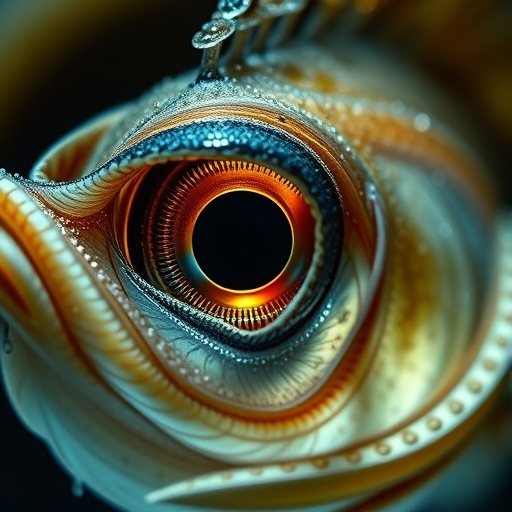In a groundbreaking study that pushes the boundaries of palaeontological research, scientists from the University of Vienna have unveiled a novel method to decipher the life histories of ancient fish with unprecedented precision. By employing an advanced technique called backscatter electron imaging (BSE), the researchers succeeded in visualizing the intricate growth rings within fossilized otoliths—tiny mineralized structures located in fish inner ears. This breakthrough not only enhances our understanding of fish development over millennia but also opens a new window into environmental changes and biomineralization processes that have occurred through vast stretches of geological time.
Otoliths, often regarded as nature’s biological timekeepers, are tiny, calcified structures embedded within the inner ears of all fish. These structures function analogously to the growth rings of trees, recording the age, growth spurts, and even the environmental conditions experienced by the fish throughout its life. Traditional methods in marine biology and fisheries science have long utilized otoliths to study contemporary fish populations, tracing growth rates, migration patterns, and population dynamics. However, the application of such tools in paleontology had lagged, primarily due to technical limitations in visualizing the fine-scale features preserved in fossil specimens.
The innovative use of backscatter electron imaging marks a pivotal change in this regard. Unlike standard light microscopy, which struggles to resolve ultra-fine details in fossilized materials, BSE harnesses electron interactions with mineralized structures to produce highly contrasted images based on the atomic number differences within the sample. By tuning the imaging parameters, the research team could reveal a rich tapestry of growth increments that were previously invisible, including rings formed on both daily and sub-daily timescales. This capacity allows scientists to reconstruct detailed “diary entries” of individual fish from thousands of years ago, with temporal resolution approaching a few hours.
Focusing on the black goby (Gobius niger) from the northern Adriatic Sea, buried for over 7,600 years beneath seafloor sediments, the scientists detected a 275% increase in identifiable growth rings compared to standard approaches. This dramatic improvement underscores the method’s sensitivity and sets a new benchmark for the fidelity with which paleobiological data can be extracted from fossil otoliths. The study’s lead author, Isabella Leonhard, emphasized that these growth increments encompass not only daily cycles but also intricate sub-daily micro-increments that hint at more complex biological rhythms, potentially linked to feeding behaviors, locomotion, or environmental stressors.
The discovery of these sub-daily increments poses intriguing questions about the internal biological clocks of fish and their responses to fluctuating ecological conditions. While the exact mechanisms behind these finely spaced patterns remain elusive, the study’s co-author Emilia Jarochowska highlights the need for controlled laboratory experiments that can shed light on the causative factors. Understanding these micro-increments could reveal how ancient fish coped with environmental pressures or resource availability, thereby offering valuable insights into ecosystem dynamics over geological timescales.
This refined imaging technique provides critical tools not only for reconstructing the life histories of extinct fish species but also for making meaningful comparisons with modern populations. As the planet faces the dual challenges of climate change and overfishing, understanding how fish have historically adapted to shifting environments becomes ever more imperative. Fossil otoliths, now accessible with great detail, offer a long-term ecological context that can inform present-day conservation strategies and fisheries management.
Moreover, the implications extend beyond ichthyology. The application of backscatter electron imaging to fossil biominerals has far-reaching relevance for paleobiology and materials science. By revealing nanoscopic growth patterns and elemental variations, BSE contributes to unraveling the complex biomineralization processes—how living organisms generate mineralized tissues—that have persisted through deep time. This understanding could inspire biomimetic designs and novel materials based on evolutionary-tested natural architectures.
The research exemplifies interdisciplinary innovation, integrating geological imaging techniques traditionally used in mineral studies with biological and paleontological inquiries. Such cross-field approaches are key to unlocking hidden data preserved in the fossil record, hitherto inaccessible with conventional methodologies. The study stands as a testament to how technological progress can redefine scientific frontiers, transforming once-overlooked fossil structures into rich repositories of evolutionary and environmental information.
Funded by the Austrian Academy of Sciences and forming part of Isabella Leonhard’s doctoral research, this work underscores the value of sustained academic inquiry into non-commercial fish species. By focusing on the Adriatic Sea’s historical fish populations, the study contributes vital baseline information necessary for assessing the impacts of anthropogenic activities and natural climate variability over thousands of years. The ability to track growth increments at such fine scales also opens avenues for detecting past episodes of environmental stress or ecological shifts encoded within otolith microstructures.
In conclusion, the utilization of backscatter electron imaging to reveal detailed growth increments in fossil otoliths represents a leap forward in understanding fish biology and paleoenvironmental reconstructions. This innovative approach provides a refined chronicle of ancient fish lives, capturing information down to hourly increments and thus enabling a reconstruction of life histories with unmatched temporal resolution. As research progresses, these methods promise to deepen our grasp of how aquatic ecosystems have evolved under the pressures of climate and environmental change, ultimately enhancing our capacity to protect marine biodiversity in an uncertain future.
Subject of Research: Fish growth increments and environmental reconstruction using fossil and modern otoliths analyzed via backscatter electron imaging.
Article Title: Revealing growth increments in fossil and modern otoliths with backscatter electron imaging.
News Publication Date: 3-Oct-2025
Web References:
http://dx.doi.org/10.1002/lom3.70006
Image Credits: Michael Stachowitch (fish) and Isabella Leonhard (otolith)
Keywords: Otolith, backscatter electron imaging, fossil fish, growth increments, palaeontology, biomineralization, climate change, fish biology, Adriatic Sea, electron microscopy, environmental reconstruction, fish life history




